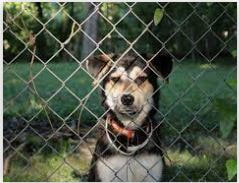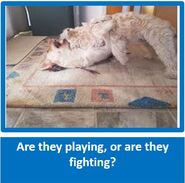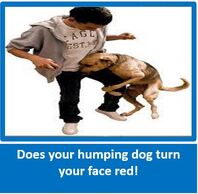
Please visit and LIKE our Facebook Page and share with family, friends and on your own Facebook page, and ask them to share further – it is only by working together and sharing knowledge and education that we can improve the lives of dogs and assist owners. We do not inundate you with posts – an average of 5 per week, and the odd Did You Know. Thank You!
Why the invisible Fence concept should not be considered
by Scotty Valadao - Friends of the Dog
by Scotty Valadao - Friends of the Dog

Firstly, exactly what is an invisible fence?
An invisible fence normally has two components - one, a collar which will issue a bleep when the dog gets too close to the wire, plus the collar has a transmitter that delivers the shock - and two, an electric wire that can be placed across a gate for example - normally buried slightly underground. These are normally used to stop dog going out of gates, or keep them off areas of garden beds or similar.
The idea is that the collar will deliver a noise, such as a ‘bleep’, to warn the dog that it is likely to get shocked if it continues further. Most of these invisible fences have a control where the shock given can be increased or reduced.
Some of the invisible fences come with flags which are used to help the dog identify the area where the electric wire is buried. Ideally dogs are trained to realize that they are not meant to go in this area.
Would we recommend these?
NO! There are several reasons why not: -
We do hope you consider the above before reverting to an invisible fence. If you have to train the dog to recognize the flags indicating an area not to be approached, is it not just simpler, to get profession help to figure out why the unacceptable behaviour (to owner at least) is occurring in the first place and be given modifications to change the behaviour - which will not be invasive or cause fear?
An invisible fence normally has two components - one, a collar which will issue a bleep when the dog gets too close to the wire, plus the collar has a transmitter that delivers the shock - and two, an electric wire that can be placed across a gate for example - normally buried slightly underground. These are normally used to stop dog going out of gates, or keep them off areas of garden beds or similar.
The idea is that the collar will deliver a noise, such as a ‘bleep’, to warn the dog that it is likely to get shocked if it continues further. Most of these invisible fences have a control where the shock given can be increased or reduced.
Some of the invisible fences come with flags which are used to help the dog identify the area where the electric wire is buried. Ideally dogs are trained to realize that they are not meant to go in this area.
Would we recommend these?
NO! There are several reasons why not: -
- Unless the owner is a behaviourist or a trainer, it is very doubtful that they would have tested the various levels of shock on themselves to determine the strength of shock given. Even then, we need to bear in mind that some dogs will be more sensitive than others (as in humans), and some dogs would need a much stronger shock, while with other dogs, even the slightest, initial setting, could freak them out.
- If a dog is engaging in a certain behaviour, one has to determine why the behaviour is happening in the first place. Questions we would ask is , ‘why is the dog running out the gate, or digging in the garden?’. Once we have established what the reason is, we would initially supply modifications to change that behaviour and very often use Management to curtail the behaviour, but not management that would be aversive. For example, for the dog that is running out the gate – we would determine if the dog was receiving sufficient mental, physical and social interaction – is the dog bored and frustrated and why – does the dog have separation anxiety – is the owner inadvertently reinforcing the behaviour by running after the dog and shouting. A great game, catch me if you can! An additionally problem here, would be that owners very often punish the dog when it does come back, making getting the dog back even harder, as it knows what is coming.
- They do not always work, especially with a dog that has a high prey drive and is busy chasing a mouse or a cate down the driveway – it would hardly even feel the shock it would be so engrossed in the chase.
- In the case of power cuts, the invisible fence may not work, If the dog approached the gate and the bleep was not heard, it may well try its luck by going closer, and eventually out the gate. On a similar vein, if a collar is being used, and the batteries go flat, the same thing can occur.
- Dogs that tend to be fearful, can either become more fearful, and can actually shut down when they feel the shock, and become petrified of going anywhere near the area, and we have known of some dogs that even refused to go out into the front yard where the gate was located.
- Additional behaviours often appear as the dog is so stressed. One that comes to mind is a dog that was successfully adopted and adored by the family. A few months after the adoption, this gorgeous dog was in serious danger of being returned to the shelter. What had transpired is that the dog had suddenly started to eliminate all over the home, especially on beds and duvets, and also started to mark furniture, which we believed was stress based.
On investigation, we discovered that the dog had access to a doggy door that led to the small back yard which it had used since arriving at the home. When we went to have a look, the dog point blank refused to go out the kitchen door. We discovered that as the back yard had only a diamond mesh fence and looked out onto a golf course, and as the dog ran, barked and lunged towards golfers, the owners had put up an electric fence on the lower section. Obviously. the dog had received a shock, and possibly to the muzzle area – there was no way it was going out there again! After fence was removed and dog was successfully desensitized to using the doggy door and back yard again, the problem was resolved – this dog nearly lost his home due to the electric fence!
We do hope you consider the above before reverting to an invisible fence. If you have to train the dog to recognize the flags indicating an area not to be approached, is it not just simpler, to get profession help to figure out why the unacceptable behaviour (to owner at least) is occurring in the first place and be given modifications to change the behaviour - which will not be invasive or cause fear?




